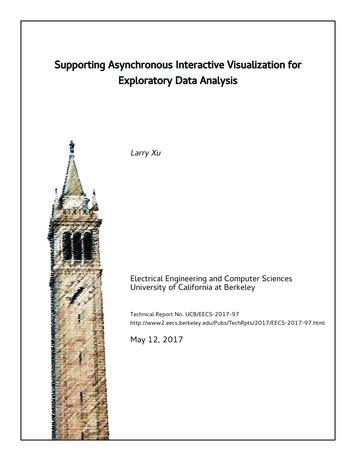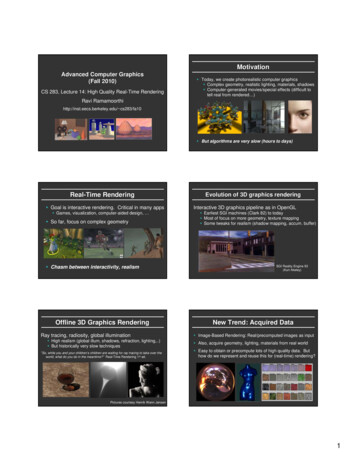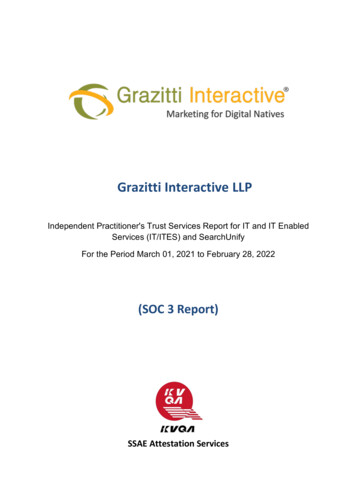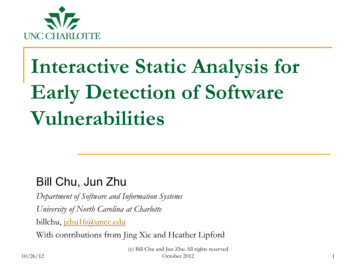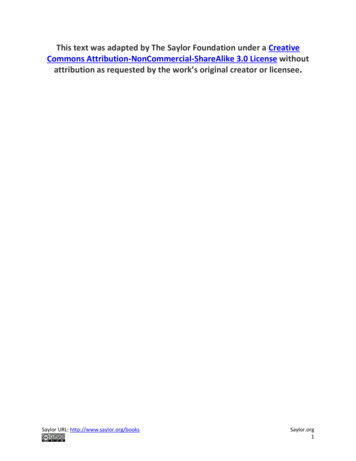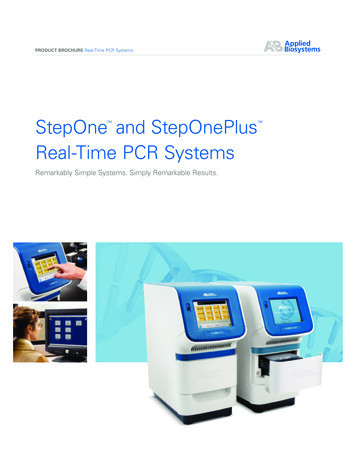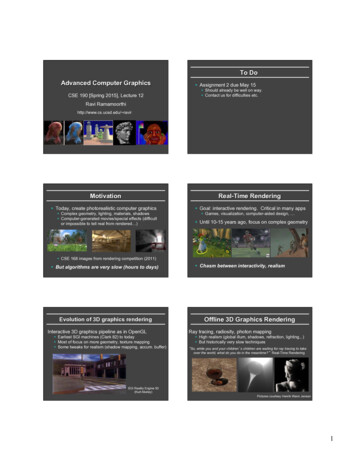
Transcription
Real-time interactive social environments:a review of BT's Generic Learning PlatformMichael Gardner and Holly WardInternet and Multimedia Application, BT Adastral Park,email: michael.r.gardner@bt.comOnline learning in particular and lifelong learning in general require a learning platformthat makes sense both pedagogically and commercially. This paper sets out to describewhat we mean by generic, learning and platform. The technical requirements aredescribed, and various trials that test the technical, educational and commercial natureof the platform are described Finally, the future developments planned for the Real-timeInteractive Social Environments (RISE) are discussedIntroductionThe vision of a single platform that supports all the key stakeholders within a wide rangeof distance learning activities has long been a dream of educationalists and commercialorganizations alike. Such a platform could not only provide a consistent educational'experience' for teachers and learners throughout their lives, but it could also provideadministration and managerial support, all of which can be tailored to individualrequirements.This paper reviews the work carried out within BT's Education and Training ResearchProgramme over the past three years in developing a generic platform for online distancelearning. The first section of the paper reviews the original objectives of the GenericLearning Platform (GLP) and the context of the education and training research withinBT. Following this, a description of the Real time Interactive Social Environment (RISE)platform is provided including the technical components of RISE.Over the past three years the research team have carried out a number of trials using RISE.Each of these intended to stretch the overall architecture and our own understanding ofwhat enables successful distance learning across a range of educational settings. Anoverview of each of these trials is given and the implications for implementing a GLP.Finally this paper closes with some comments on the future of RISE.17
Michael Gardner and Holly WardReal-time interactive social environments: a review of BTs Generic Learning PlatformThe meaning of genericIn the context of our work, we define 'generic' as a solution that is not dependent upon anyparticular individual's learning stage, be it at school, college, university or work. Such adefinition is essential to support meaningfully the notion of lifelong learning. The conceptof learning being generic has two important implications. First it assumes that there isgreater commonality rather than differences at the developmental stages of learningthroughout most of our lives. The learning process is essentially universal, although it mayrequire degrees of customization to meet some of the specific needs of the learners at theirdifferent developmental stages, situations or locations. Many of these learning issues willbe addressed in the next section.Generic solutions also make considerable commercial sense. Solutions specifically designedfor each sector (i.e. schools, colleges, universities and learning for leisure) are expensive andmay not facilitate movement between sectors as required by a lifelong learning scenario. Ageneric solution recognizes a common core which may be customized to suit the needs of asector (see section on the platform for more details on customization). Finally the term'generic' is also making a statement about content that has both educational andcommercial implications. Content is the critical component that needs to change to reflectthe differing educational requirement - it cannot be generic across sector, at best it iscommon for a single homogeneous group of learners. The GLP, with respect to content atleast, must be considered as a generic 'shell' into which appropriate content can beadded. Commercially this also makes sense as BT does not consider itself as a contentprovider and works with third parties who have a high reputation in the area of contentprovision.Our aim therefore was to produce a platform that was sufficiently generic to allow the'reuse' of basic or core components across the market sectors, thus keeping developmentcosts down, and sufficiently universal in terms of learning to provide a shell that requiresthe minimum of customization. To achieve this aim requires a conceptual framework thatserves as a bridge between the theoretical academic educational research and thepracticalities of implementing real distance learning systems. It can also provide aconsistent framework for the design of systems and an evaluation framework in which toassess them. A true test of the generic nature of the platform is best assessed throughempirical trials. Trials of the GLP in the higher education, further education and schoolsectors are described in later sections.The meaning of learningThe theoretical background and underpinning for the GLP was provided by Mayes's'learning framework' (1994). The original Mayes framework (1994)1 is illustrated in Figure1 and can be summarized in the following way: Conceptualization: this refers to the student's initial contact with learning material.This could be achieved by attending a lecture or seminar, reading textbooks, watchingtelevision, listening to the radio or by using multimedia material on the Web. Construction: at this stage students build on the concepts learnt in theconceptualization phase and refine their understanding by working on further tests and18
AJt-JVolume 7 Number 3examples. This could be achieved by carrying out laboratory experiments or workingon practical homework, or using multimedia learning materials.Dialogue: at this stage students refine their understanding through dialogue anddiscussion. This could be achieved by participating in tutorials or having informal andsometimes impromptu conversations. On the Web this could be supported by usingshared whiteboards, conferencing tools (e.g., audio, video, data conferencing etc.) morecomplex shared spaces, or discussion ngConstruction,Figure I: Mayes's conceptual frameworkIn general within the sphere of commercial distance learning platforms there has beenmuch greater emphasis on supporting conceptualization, much of it through thedevelopment of multimedia Web and CD-ROM content. There tend to be fewer tools tosupport construction and dialogue as part of an overall educational process. It is for thisreason and also the suitability of the constructionist approach to distance learning, i.e. alearner-centred approach, that much of the team's research is aimed at supportingconstruction and dialogue within this overall educational framework. The key is to identifyand support the complete end-to-end 'education process' rather than focus primarily onthe end-products of education, e.g. teaching and learning content. The initial requirementtherefore for the GLP was that it would support the three-stage Mayes model.From a commercial perspective the GLP is attractive to BT because it could provide asingle service platform which could be used to provide tailored services to different marketsectors, i.e. higher and further education (HE/FE), schools, home etc. In this context the19
Michael Gardner and Holly WardReal-time interactive social environments: a review of BTs Generic Learning Platformplatform would need to support a much wider range of functions than just those covered inMayes's model. A service definition for the FE sector, as shown in Figure 2, illustrates this.BT Home PageCompetencyAnalvsis Job ProfileAnalysis NVQAnalysisI earning Style I AnalvsisIDirect AccessiIEducation MallRegistration/AuthenticationCollege Complete Resource PortfolioBusinessHumanitiesAn & DesignContemporary StudiesEngineeringCorporate & SMEEDUCATIONAL SUPPORT Counselling, remedial work1Diagnostic toolsIBROKERAGE ADMINISTRATIONIRecords & Support1Billing1I Figure 2: A typical service definition for the FE sectorIn this diagram the service definition is made up of five key components: Access point: in its simplest form this could be a homepage, but could be more complexif considered as part of a larger range of online educational services.Analysis and profiling: tools need to be provided to assist a student or teacher to gainaccess to the appropriate online resources. For example this can include competency,job profile, or learning style analysis, or it could be based on a defined curriculum, e.g.a National Vocational Qualification (NVQ), or direct access to online resources usingadvanced search and retrieval tools.Administration: this can be the most important component for educationalinstitutions, and will include the user registration and authentication process, tracking,support, billing and content provision.Online resources: there will need to be a method for classifying online learningresources and structuring the methods of access. Also in its widest context, onlineresources can include multimedia content, live and pre-recorded lectures, real people,e.g. tutors, and also resources generated by the students themselves.Support functions: these will include a range of support functions such as access totutors and mentors, counselling and remedial tools.The BT generic learning platform therefore needed to support not only the Mayesconceptual framework, but also other functions, as defined above, that are necessary toprovide a complete online service.20
Ak-JVolume 7 Number 3Development of the RISE platformRISE is the instantiation of the GLP that we have developed at BT. Its development hasbeen an iterative process based on a series of trials. These trials were deliberately chosen tostretch the platform and so lead to a better understanding of the issues involved indeveloping a GLP. This section describes the development of the RISE GLP throughresearch trials.RISE architectureThe RISE system had to provide the following core functions: Personalized access to online information based on the online group of students, tutorsand support staff. Each person would have a personalized information spacerepresenting their role within the group and the actual work that they had eachcompleted. A virtual classroom or meeting-place which could provide access to good-quality multiparty audio conferencing between participants, and the ability for users to shareinformation and record their conferences. Public and private information spaces where students could store their audiorecordings and coursework. An online shared diary to enable participants to plan their schedules online. Access to a modular set of coursework based on defined stages, modules and checkpoints,plus tools to enable the teaching staff to update and manage the course materials. Email and text discussion groups. Personalized home pages.To meet these requirements RISE required three essential features: the integration of anaudio conferencing capability with the Web; a dynamic database-driven Web server whichcould be personalized to each individual user; an online dynamically updating WebMeeting Place. The RISE architecture is illustrated in Figure 3.RISE is designed around the combination of a data-driven Web server and an audioconferencing server. The Web server is a standard Microsoft Internet Information Server(IIS) on a Windows NT platform. All of the RISE application software is written in AppleWebObjects. WebObjects builds the Web pages dynamically according to the business rulesin the RISE application and the underlying data in the Oracle database. In addition to theRISE application there is a separate ConfMan application that manages all conferencesand acts as an interface to the Aculab Millennium audio-conferencing platform. TheAculab Millennium is connected to two ISDN-30 lines that will support at any one time upto 60 callers in conferences. Also there is a separate Java server application called REEL.This provides a Web page-sharing capability to users in a conference. Using a simple JavaApplet conference participants can push Web pages to each other's browsers. Users ofRISE only require a Java-enabled Web browser, e.g. Internet Explorer 3 or Netscape 3 .No additional client-side software is required.21
Ak-JOracle Datahav.'Volume 7 Number 2.IAudioconfBridge(Acokb)Confraan-RISE,".' Web ' '.'".""Reel-.*' server?Ir,rW e b ' '"/Reel'-'Browser* :.'Q'ava) .- irr1WebReel-Browser* " (Java)figure 3: R/SE architectureThe key to RISE is the underlying database and the structure of the data schema. Figure 4shows the data schema used in the Merlin trial. In many ways the success of the GLP willbe dependent on the richness and flexibility of this data schema to support a range ofdifferent distance learning scenarios. Irrespective of the other technologies used, the dataschema defines the distance learning model for the GLP and should be at the core of anynew online service.RISE is built around the ability to create any number of separate closed user groups. Usinga number of Web-based online forms a system administrator can create and configure aclosed user. For each group, the administrator must configure the group, the roles of usersin the group, e.g. tutor, student, administrator, etc. and the layout and functions availableto the group. In this way RISE can be used to create a customized system to support aclosed user group of individuals. By using the database to build dynamically the onlinepages for each user it is relatively easy to administer the RISE groups based on thedatabase schema and the customizable options available in RISE. Merlin represents onesuch closed user group and the Merlin requirements influenced the development of thefirst version of RISE. However, it was recognized from the start that any GLP mustsupport a large range of different course and learning models, which is why a range ofdifferent trials were carried out in order to extend the capabilities of the RISE GLP.RISE interface and functionalityThe user must first log into RISE with their username and password and the group thatthey belong to. Once successfully logged in, the user will be presented with two windows,see Figure 5. The larger window contains a toolbar and a workspace area. The toolbarbuttons and the 'look and feel' of this window are all dynamically configured for eachgroup. The smaller window is the Web Meeting Place and allows users to see who else isonline in their group, enabling them to initiate and take part in audio-conferences withother users. Once in a conference, users can record their conversation, invite other people,and control the privacy of the conference. They can also share Web pages with one anotherusing the REEL Applet, see Figure 6. BT has secured two patents on the RISE systemconcerning the way the Meeting Place is used to control audio conferences and the use ofthe REEL application to share Web pages. RISE also provides email and discussion groupfacilities for all users within the group.22
Ak-JENOUIRY TYPESTUDENT REPORISVolume 7 Number 3PERSON ERMINAL STEPPERSON.STAGESTEPDirection of relallonshlpFigure 4: The Merlin Data Model23
Michael Gardner and Holly WardReal-time interactive social environments a review o f BTs Generic Learning PlatformFigure 5: R/SE gure 6: Reel AppletWindowAs part of the RISE core functionality each user has access to their own private folder anda shared folder which is available to everyone in the same group. These folders can be usedto store any work completed by individuals in the group. Work items can include audiorecordings from RISE conferences or any uploaded computer file. Users can easily uploadfiles from their own PC into these folders for their own use, to share with the tutor, or toshare with the whole group. When audio-conferences are recorded the system convertsthem automatically into RealAudio format. This allows users to stream the audio file backto their PC when they want to listen to it, rather than downloading a large file to their PC.Users can also email the URL of the recording to another person.In addition to the RISE Meeting Place, the students and teachers also needed a way ofscheduling when they would be online, and organizing conferences with one another. It is24
Ait-]Volume 7 Number 3possible to organize conferences formally using asynchronous tools such as email.However, this can be inappropriate if students or teachers want to organize informallytheir 'online time' to ensure that they will be online when others in their group are alsoonline. To meet this need we developed a shared online diary in RISE, see Figure 7. Thisallowed users to publicize when they intended to be online. Students could organize theiruse of the system when others would also be online. This type of informal groupwaresupport is crucial to the success of any distance learning group.Figure 7: The Merlin DiaryThe testing of RISEThe first use of RISE was in the Merlin trial (Miller, 1996) which ran from October 1996through to June 1997. The Merlin project was a collaborative project between BT and theUniversity of Hull Language Institute. It was primarily designed around a 16-week Englishas a Foreign Language (EFL) course delivered online to 40 students world-wide. Merlinwas influential as it defined the requirements for the first version of RISE and provided thecore features for all subsequent trials. Merlin also set the model for future collaborations,whereby BT acted as a service provider of RISE to an educational organization. Throughthese trials we learnt a lot about how this relationship could work effectively, how tofacilitate the understanding of requirements and how to enable essentially non-technicalteaching organizations effectively to deliver courses online via the Web.Merlin required the following core features: Conceptualization: a 16-week modular course with assessment points. The content forthe course would be released at set periods under the control of the tutors. Construction: students had to be able to practise their English with a peer group andtutors, be able to record their spoken work and share it with others on the course. Theyhad to complete a range of online exercises and save results as well as access standardcourse materials.25
Michael Gardner ond Holly Ward Real-time interactive social environments: a review of BTs Generic Learning PlatformDialogue: students and tutors had to be able to hold both formal and informalmeetings using audio conferencing and be able to share information online.The Merlin trial had distinct requirements in terms of the provision of online coursewareto the students. The EFL course was based on a 'pathway' of eight separate stages withcheckpoints at the end of each stage, e.g. a formally assessed exercise. Within each stagewere a number of separate modules that students could work through to enable them tocomplete the stage. The key for RISE in this scenario was to enable the course deliverers,Hull University, to manage their courseware and the extrinsic course process. A number ofcourse management tools were developed to meet this end. These tools allowed the Hullteam to add dynamically new modules and exercises using bespoke administrator forms. Inthis way the course material could be released over the 16-week period and the tutors coulddynamically update the material based on students' progress and lessons learnt from thestudents' use of the previous courseware. We also provided the Hull team with a basicApplications Programming Interface (API) which allowed them to develop course materialwhich included online exercises. The API allowed the courseware team to define theseexercises in a way that allowed the students to store their answers to the exercises in theMerlin workbook areas, and index these answers against the specific part of the EFLpathway that they came from. In summary, these tools allowed the course providers to havecomplete control over the online courseware and be able to build assessable courseexercises, which could be tracked against each student. In addition to using these tools, anyWeb-based content could also be linked into the system as courseware or as an onlineresource.The Merlin trial had fairly specific requirements for the EFL course based on a strictmodular course structure and a rigid curriculum. This type of formal course structure isfairly commonplace. There are many similarities to other school and HE-based curricula.However, particularly in vocational courses there is a need to support a much more flexiblecourse structure, one where the emphasis is more on the learner to assemble evidence ofparticular competencies that can then be assessed by a tutor, e.g. a student undertaking anNVQ. In 1997, BT ran a second trial using the RISE platform in collaboration with NorthernColleges Network (NCN), a group of FE colleges in the Northumberland region. In additionto testing the core technologies, the key objectives of this trial were to evaluate the usabilityof a GLP in the FE sector, increase awareness of online learning throughout the FE sectorand provide early indications of the acceptability of technology for online learning. Inaddition to this the team investigated the effects of organizational factors on implementationof online learning (Ward, Tracey and Barker, 1998).During this trial the BT team worked closely with the NCN tutors and administrators todevelop a version of RISE to deliver the NVQ Level II in Information Technology. The keyrequirement for the RISE platform in this instance was the need to support the NVQ process.To meet this end, a number of enhancements were required. This included an NVQ ScheduleManagement Tool to allow students to monitor and update their progress against allelements of their NVQ. Tutors could also use the tool to oversee and monitor the students'progress and update the schedule when necessary, e.g. following formal assessment.Another requirement from the NVQ process was fully to support the collection andassessment of student evidence documents. In Merlin, Personal and Group 'workbooks'26
Alt-JVolume 7 Number 3were provided to allow users to store items such as recordings of conferences andcompleted coursework. The NVQ process required that the system could more formallysupport the process of capturing, sharing and assessing evidence material. To meet thisneed four 'workbook' areas were created: an 'audio-evidence' folder, where students could save private recordings from audioconferences; a 'meeting records' area, where users could save shared meeting recordings; a 'progress review' area, where students could upload documents related to the formalNVQ progress reviews; a 'text evidence' folder, which could be used by students to maintain a store of all theirdocuments related to the evidence required.The access privileges to all of these folders were managed by the RISE system to ensurethat students only had access to their own records, and tutors could access all records forall of their students.So far the RISE platform had only been used to support formal distance learning coursesbased on a curriculum of task activities and formalized assessment points. The next keyquestion was whether the GLP could be applied to less formalized learning communities,where rather than supporting a set curriculum the GLP needs to support the generalcommunications and learning needs of the community. To investigate this scenario theHomeLearn trial was initiated. This was a collaboration between BT and Apple ComputerInc. and used Wickham Market Primary School in Suffolk as the case study (James, 1999;Tracey, Fowler and Penn, 1999). The aim was to investigate how RISE could be used tosupport the relationship between home and school. Students from Years 5 and 6 and theirfamilies participated in the trial. They were provided with a PC and an Internet connectionat home. RISE accounts were created for teachers, students, their families and a schoolgovernor. No additional 'content' was created to support this trial as an explicit course wasnot being run. Instead the team investigated the communication needs of participants. Tomeet this requirement RISE was extended to include facilities for: Tracking and managing students' homework. The teacher could create, assign and monitorhomework for the trial students. Students could track their homework and parents couldmonitor their child's homework and electronically authorize it as being 'seen'. Publication and sharing of school's long- and medium-term plans. A tool wasdeveloped to allow the teacher to create daily short-term plans and publish them for thetrial community. Discussion group areas were extended to allow a greater variety of discussion areas.Some were only open to distinct user sub-groups, e.g. children-only or parent-only. Thisalso included project-specific individual and group folder areas, which could be used tosupport specific activities. The RISE conferencing facility was extended to allow invited experts to attend speciallyorganized conferences as part of the students' project work, e.g. a meteorologist in thegeography class.27
Michael Gardner and Holfy WardReal-time interactive social environments a review of BTs Generic Learning PlatformA further RISE trial was conducted in collaboration with the University of the Highlandsand Islands (UHI) in 1999. This used the RISE general purpose group and conferencingfacilities to support the delivery of online lectures to a group of students undertaking asoftware engineering B.Sc. course. Students and lecturer would log into RISE and jointogether in an audio conference using the RISE Meeting Place. Once in a conference, thelecturer would use the REEL tool to 'push' lecture slides to each student's Web browserwhilst giving the lecture as an audio conference. In addition to the UHI trial with RISE,the BT team have developed a number of other tools as part of an Advanced LearningEnvironments (ALE) project to assist in the capture and synchronization of slides andaudio and in archiving and distributing lecture material (see Mudhar and Fowler, 1999).Our final trial is ongoing and involves working with Suffolk College on a European SocialFund (Adapt) project, COVETS, to develop a Televersity' platform for Suffolk. At theheart of the system will be Solstra (http://www.solstra.com/), which will provide all of theuser registration and content provision aspects. RISE will be integrated into this system toprovide support for the community conferencing and the upload and sharing of individualand group work. The plan is to test this platform through some early trials based onspecific courses, but widen this out to address many of the issues raised by the UKGovernment University for Industry (UFI) initiative. A particular focus will be onproviding education and training to meet the needs of a wide range of different people inthe community and laying some of the foundations for the support of lifelong learning.This section has described the development of the RISE Generic Learning Platform basedon a number of trials with different educational contexts. The next section highlights someof the key findings from the evaluation of some of these trials.Key findings from trialsSystem usabilityAs with any experimental software the trials encountered some technical problems. Thosehighlighted in the early trials were overcome and RISE was refined for the following trial.The key problem, identified during the Merlin trial, surrounded the issue of integration.Users were uncomfortable using several applications at the same time and frequentlyrequested a combined user interface from which to launch all applications. To resolve thisFirstClass and RISE were integrated into the same browser for the NCN trial. The resultwas positive feedback from the users. This demonstrated that RISE was a tool with anacceptable level of hidden technology, the user simply logged on and completed a taskwithout identifying that they were using two different applications.Many of the users expressed a desire to have multi-party video conferencing facilities builtin to the RISE platform in addition to the audio conferencing tools already available. Priorresearch had indicated that users were less interested in 'seeing' one another than they werein actually completing the task at hand, e.g. sharing a Web page, and preferred betterquality audio and faster data-sharing facilities than a video image. During the UHI trialBT carried out a comparison of lectures delivered using video conferencing to thosedelivered over the audio link built in to RISE. The students reported that the quality of thevideo conferencing was very poor but they still felt that actually being able to see theirlecturer was beneficial. However, the lecturer suggested that video conferencing 'didn't add28
Alt-JVolume 7 Number 3a huge amount over audio conferencing'. He was comfortable using RISE to deliver andsupport his slide material. Despite students' early concerns, at the end of the trial all of thestudents 'preferred using RISE to the video conferencing' (Tracey, 1999).It should be noted that students who were already friends or had met their tutor prior tothe trials were comfortable conferencing without a video image. Only those who had noprevious contact were initially uncomfortable with an audio link alone. Many userscommented that making contact with a complete stranger is much harder in a 'virtual'environment than it is in a 'real' classroom. However, as the users familiarized themselveswith the system, the course and their peer group, their confidence grew and their need forthe visual cues changed. This highl
audio conferencing capability with the Web; a dynamic database-driven Web server which could be personalized to each individual user; an online dynamically updating Web Meeting Place. The RISE architecture is illustrated in Figure 3. RISE is designed around the combination of a data-driven Web server and an audio-conferencing server.
